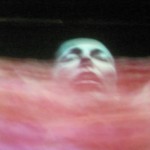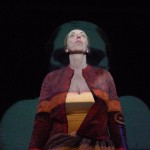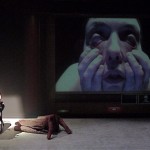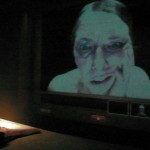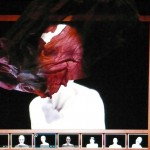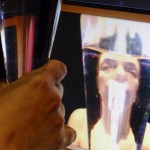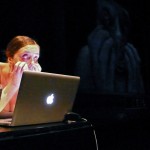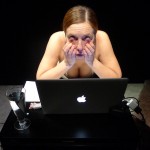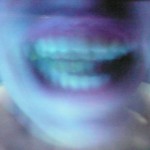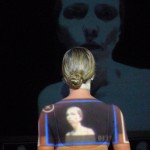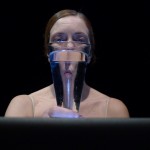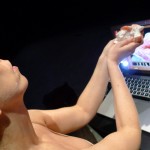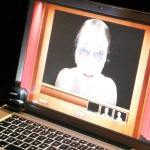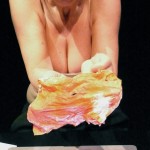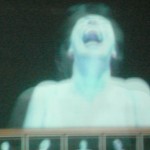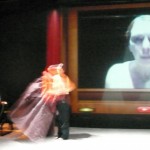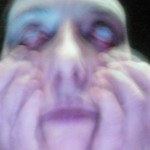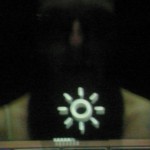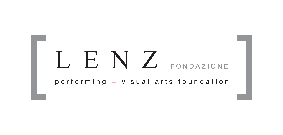
PENTESILEA
Last Queen of one's own exclusive Self, solitary Amazon with no bow left, bites and tears itself with the voluptuousness of words in verse and with the pointed arrows of photo booth self-portraits of a powerbook. Live author of her own serialization inside the box of the present time – handwriting that fixes the moment of the authorial act and feeling – self-edifies the dialogue, the fight between the present Ego and the newly imprinted Ego, spreads across the battlefield, breaking down into dialogic conflictual relationships, loving, rancorous, to the limits of the murder of the Self, of the all-encompassing Selbst. The physical body appears, he frees himself from the theatrical envelope and operates at the MacLibro as at the console of his own life. The water in the glass drowns it inside the enlarged image in a black screen, stage/mouth that swallows everything and the steel book becomes sharp and pointed like a knife.
Because now I go down into my breast, like a well, and I dig out, cold as metal, a feeling that destroys me.
This metal, I purify it in the fire of a cry of pain as hard as steel; then I bathe it with the acidic poison of repentance, from side to side; I bring him to the eternal anvil of hope, and I sharpen it and point it into a knife; and to this knife I now offer my chest: As! As! As! As! It's still! – Now it's okay.
The O-shaped sun of the luminous icon sets, gradually extinguishing like the time experienced by the actress and her double photo booths. Kleist alla cugina Maria von Kleist: “I completed Penthesilea. It is true, it's my most intimate nature … all the filth and at the same time the splendor of my soul.”
In search of the breath that precipitates the word fully in front of him, the actor suspends himself – amazed – in the void that the word itself will create. Word born in the womb, still silent rise to the vocal cords, enemy to the brain, word that seeks an exit through the holes of the flesh. When it forms? When it takes shape? Inside, out? The actor exposes his body, the word is in there, locked up, she mutes and looks at us from her body, he spies on us from his eyes and warns us that he may never come out. When and how she decides. The actor's body only contains it and it bounces inside, kicked, hides, it causes him terrible suffering, he chews it all up, now fast, now slow, the fight has begun and the actor knows it. He knows that once outside he will disappear into his void, which will be the only and last one, who will abandon him there, solo, harmless wrapping like a puppet. “Here you stay, and without sound (silently). When the whole body has sunk into the other world, the real one of the theater, then it came out nice and clean, sacred and pure, bold and fair. The actor's body opened the door, he crossed the threshold, allowed her entry, he made himself transparent to her, he offered himself to her.
This is the actor's sacrifice, carry the seed within oneself, from the first day of testing, feel the growth within yourself, the pulsation, the rhythm of a new heart, contain the new life until the moment of birth that the word decides for itself. The actor's work must be done continuously "from scratch", the body must clean itself of all encrustations, of every false posture, of affectation, of the surface of everyday life. In this long process of purification, dramaturgy undergoes radical modifications, it changes as the growth of the word evolves, in the realization of the actor's new consciousness.
The director's task is to prepare the actor's body to receive the word, to lead him to inhabit the scene of birth, to help him be alone when the word will empty him. The body of the actor in solitude contains within itself the gaze of the director, the eyes, the hands, the legs multiply. The director is only the author of this multiplication, here lies its necessity. The actor is female, as Valère Novarina rightly says. Only the female body can grow a word that has the colors of birth when it appears. Only a woman's eyes can convey the fury of Penthesilea, the deadly pace of an Amazon. The male just has to pretend, in the truth of the body on stage, not to be a plague victim, to be a soldier, to be a hero. Kleist asked a woman to help him put an end to the pretense.
by Pentesilea by Heinrich von Kleist
translation | playwriting | Francesco Pititto
regia | installation | costumes | Maria Federica Masters
musica | Andrea Azzali_Monophon
interpreter | Sandra Soncini
production | Lenz Refractions
Lenz Refractions: the search for the contemporary
By Andrea Porcheddu, Linkiesta, 14 March 2013
What are we talking about when we talk about contemporary theatre? It sounds like a Carverian title, or a doubt of Monsieur Lapalisse.
Wanting to resolve the issue quickly, in two minutes, three words are enough: the theater that is done in our time. It's eight words, but less than two minutes.
But if you look closely, It's a trick question.
The other evening I went to Parma. I hadn't been back for many years. The occasion was a double invitation from the Lenz Rifrazioni company. The group, called by all Lenz, led by Maria Federica Maestri and Franscesco Pititto, he has been an undisputed protagonist of Italian theatrical research for years. His language, often extreme, always conceptual, does not exclude the comparison with harsh physicalities – what Romeo Castellucci called the “forgotten beauties” – that is, that broad humanity that is often marginal and experiences the dynamics of diversity.
Lenz's research, In short, always in that beautiful theater created with courage and dedication in an industrial warehouse, it is deeply rooted in the tensions and contradictions of our time.
The shows, so, there were two. The first is a monologue, entrusted to the excellent Sandra Soncini, that runs through the myth of Pentesilea in Kleist's compositional vertigo. A monologue inexorably said in front of the Mac screen, which multiplies and magnifies the foreground on the background. Penthesilea alone with herself, disarmed queen, he marries himself in chat: until he devours his own myth like a glass of water. It's a story that becomes delirious, obsession, self-dialogue of those who desperately search for traces of life in the glare of the screen, help, I listen.
Then, a more complex and detailed job, Aeneas in Italy, which sinks into’Aeneid like a knife, drawing a bitterly Italian essence from it, capable of uniting the legend of the founding father of Rome with the armed struggle of the Seventies.
Lenz has made a great multi-year journey on Virgil's work, divided into chapters corresponding to the books of the Aeneid, precisely to reflect on the founding myths of the "Homeland" (the quotation marks, given the Italian situation, they seem obligatory to me).
I saw the last chapters – from 7 al 12 – rely on three naked bodies, smeared in white, two men and a woman. They play, they fight, they argue, they collide, they jump, they dance, they talk. They're screeching, amplified by the dark sound – elaborated live by Andrea Azzali – which makes the Aeneid a score of suffering, a mythical story that instead tells of bestiality, violence, oppression. In the eternal return of the same of an ever devastated Italy, inked, vulgar.
After the suggestive and disturbing Hamlet in the enormous space of the Farnese Theatre, Lenz therefore continues to shuffle the cards of the classic and the myth, radically reforming the canon in the name of the contemporary.
Ecco, so, because I was wondering what contemporary was and when contemporary theater ceases to be contemporary.
We can say, trivially, that the theater is contemporary with itself, in his time? Ecco, This is where doubt creeps in. Who deals with contemporary art, he knows that ultimately it has to do with the question of Time. Federico Ferrari remembers it very well, in the introduction to an agile volume with the significant title of “Of the contemporary“. Theater seems to be contemporary almost by definition: how many times have we heard about hic et nunc, that is, of being present and alive precisely in the moment in which they are two communities – that of the actors and that of the spectators – who meet. The look, the body, the word are the connotating elements of being present at the scenic event, which is therefore a shared time. But this does not answer the initial question. What is contemporary theater and why does it have to do with time. Ferrari remembers that we, we the human species, we are in time: we are born entering time and die leaving it. AND, basically, to paraphrase Malraux, the “human condition”. So much so that all philosophers – from Parmenides to Heidegger to Nieztsche to Giorgio Agamben – they questioned themselves on the founding question, what is time: fulcrum of philosophical thought and therefore fulcrum of artistic thought and practice. From this perspective – I summarize and make Ferrari's thoughts my own, I hope the author will forgive me – the “classics” sit on the edge of time, and wait for fashions to pass, trends, the frenzy of the moment. They carry eternal values and standards – some would say archetypes, who eternally return. On the other side, Instead, contemporary art: the new that advances, that dives into time, and tells it, tireless in its ever-changing nature, changing.
They are dichotomous forms? Conflicting? Yes, they often are. The classic loses sight of the real, certainly contemporary ages immediately. But finally there is another way of being classic and contemporary: a way in which the ferment renews the classic and the classic confirms the ferment. Today we live in a time of accelerated theater: in duration, in the production, in use. Thomas Ostermeier, to whom we owe this definition, tells us this well: it is a theater that thrives on communicative acceleration, social and at the same time contributes to reflecting on the present time. Yet in this acceleration, the theater has not lost sight of its relationship with Time. I like to shoot, about this, a now famous definition by Agamben on the contemporary: «he is contemporary who does not actually coincide with his time nor adapt to its demands and is, therefore, in this sense, out of date. But precisely through this gap and this anachronism, he is capable more than others of perceiving and grasping time".
Here then, what contemporary theater is. That theater "outside" the present time for a little girl, lieve sfasatura. A point of view, a perspective, a narrative ability. Ci dice Jean Luc Nancy, in the same booklet cited, that contemporary works therefore not only force us to take on that transversal look at ourselves and our time, but they push us, always again, to ask ourselves the incessant question of what the contemporary is. That is to say, through our gaze – which is a curved gaze, which returns to us through the gaze of the actor - the contemporary forces us to ask the question of what art is, that is, the theatre, that we are living, or what the world is, and the society we are living in. With Lenz Refractions, with other Italian companies and groups, this happens.







